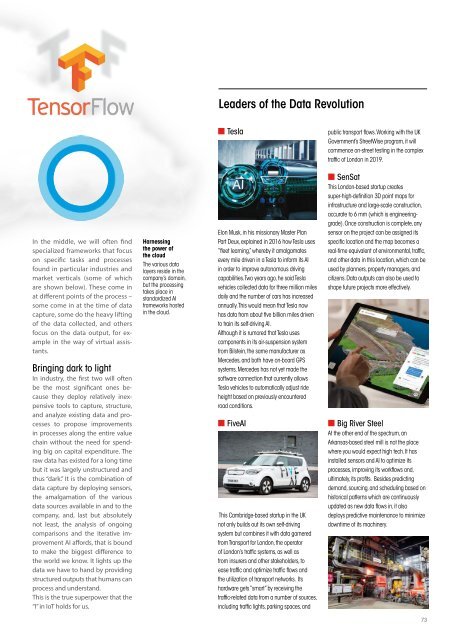Smart Industry 2/2018
Smart Industry 2/2018 - The IoT Business Magazine - powered by Avnet Silica
Smart Industry 2/2018 - The IoT Business Magazine - powered by Avnet Silica
You also want an ePaper? Increase the reach of your titles
YUMPU automatically turns print PDFs into web optimized ePapers that Google loves.
Leaders of the Data Revolution<br />
■ Tesla<br />
public transport flows. Working with the UK<br />
Government’s StreetWise program, it will<br />
commence on-street testing in the complex<br />
traffic of London in 2019.<br />
In the middle, we will often find<br />
specialized frameworks that focus<br />
on specific tasks and processes<br />
found in particular industries and<br />
market verticals (some of which<br />
are shown below). These come in<br />
at different points of the process –<br />
some come in at the time of data<br />
capture, some do the heavy lifting<br />
of the data collected, and others<br />
focus on the data output, for example<br />
in the way of virtual assistants.<br />
Bringing dark to light<br />
In industry, the first two will often<br />
be the most significant ones because<br />
they deploy relatively inexpensive<br />
tools to capture, structure,<br />
and analyze existing data and processes<br />
to propose improvements<br />
in processes along the entire value<br />
chain without the need for spending<br />
big on capital expenditure. The<br />
raw data has existed for a long time<br />
but it was largely unstructured and<br />
thus “dark.” It is the combination of<br />
data capture by deploying sensors,<br />
the amalgamation of the various<br />
data sources available in and to the<br />
company, and, last but absolutely<br />
not least, the analysis of ongoing<br />
comparisons and the iterative improvement<br />
AI affords, that is bound<br />
to make the biggest difference to<br />
the world we know. It lights up the<br />
data we have to hand by providing<br />
structured outputs that humans can<br />
process and understand.<br />
This is the true superpower that the<br />
“I” in IoT holds for us.<br />
Harnessing<br />
the power of<br />
the cloud<br />
The various data<br />
layers reside in the<br />
company’s domain,<br />
but the processing<br />
takes place in<br />
standardized AI<br />
frameworks hosted<br />
in the cloud.<br />
Elon Musk, in his missionary Master Plan<br />
Part Deux, explained in 2016 how Tesla uses<br />
“fleet learning,” whereby it amalgamates<br />
every mile driven in a Tesla to inform its AI<br />
in order to improve autonomous driving<br />
capabilities. Two years ago, he said Tesla<br />
vehicles collected data for three million miles<br />
daily and the number of cars has increased<br />
annually. This would mean that Tesla now<br />
has data from about five billion miles driven<br />
to train its self-driving AI.<br />
Although it is rumored that Tesla uses<br />
components in its air-suspension system<br />
from Bilstein, the same manufacturer as<br />
Mercedes, and both have on-board GPS<br />
systems, Mercedes has not yet made the<br />
software connection that currently allows<br />
Tesla vehicles to automatically adjust ride<br />
height based on previously encountered<br />
road conditions.<br />
■ FiveAI<br />
This Cambridge-based startup in the UK<br />
not only builds out its own self-driving<br />
system but combines it with data garnered<br />
from Transport for London, the operator<br />
of London’s traffic systems, as well as<br />
from insurers and other stakeholders, to<br />
ease traffic and optimize traffic flows and<br />
the utilization of transport networks. Its<br />
hardware gets “smart” by receiving the<br />
traffic-related data from a number of sources,<br />
including traffic lights, parking spaces, and<br />
■ SenSat<br />
This London-based startup creates<br />
super-high-definition 3D point maps for<br />
infrastructure and large-scale construction,<br />
accurate to 6 mm (which is engineeringgrade).<br />
Once construction is complete, any<br />
sensor on the project can be assigned its<br />
specific location and the map becomes a<br />
real-time equivalent of environmental, traffic,<br />
and other data in this location, which can be<br />
used by planners, property managers, and<br />
citizens. Data outputs can also be used to<br />
shape future projects more effectively.<br />
■ Big River Steel<br />
At the other end of the spectrum, an<br />
Arkansas-based steel mill is not the place<br />
where you would expect high tech. It has<br />
installed sensors and AI to optimize its<br />
processes, improving its workflows and,<br />
ultimately, its profits. Besides predicting<br />
demand, sourcing, and scheduling based on<br />
historical patterns which are continuously<br />
updated as new data flows in, it also<br />
deploys predictive maintenance to minimize<br />
downtime of its machinery.<br />
73
















